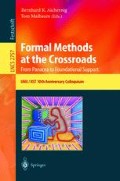Abstract
We look at the main issue of the Colloquium “Formal Methods at the Crossroads from Panacea to Foundational Support” reflecting on our rather long experience of active engagement in the development and use of formal techniques. In the years, we have become convinced of the necessity of an approach more concerned with the real needs of the software development practice. Consequently, we have shifted our work to include methodological aspects, learning a lot from the software engineering practices and principles.
After motivating our current position, mainly reflecting on our own experience, we suggest a Virtuous Cycle for the formal techniques having the chance of a real impact on the software development practices. Then, to provide some concrete illustration of the suggested principles, we propose and advocate a strategy that we call Well-Founded Software Development Methods, of which we outline two instantiations.
Work supported by the Italian National Project SAHARA (Architetture Software per infrastrutture di rete ad accesso eterogeneo).
Access this chapter
Tax calculation will be finalised at checkout
Purchases are for personal use only
Preview
Unable to display preview. Download preview PDF.
References
Astesiano, E., Bidoit, M., Kirchner, H., Krieg-Brückner, B., Mosses, P.D., Sannella, D., Tarlecki, A.: CASL: the Common Algebraic Specification Language. T.C.S. 286(2), 153–196 (2002)
Astesiano, E., Krieg-Brückner, B., Kreowski, H.-J. (eds.): IFIP WG 1.3 Book on Algebraic Foundations of System Specification. Springer, Heidelberg (1999)
Astesiano, E., Reggio, G.: Direct Semantics of Concurrent Languages in the SMoLCS Approach. IBM Journal of Research and Development 31(5), 512–534 (1987)
Astesiano, E., Reggio, G.: SMoLCS-Driven Concurrent Calculi. In: Ehrig, H., Kowalski, R., Levi, G., Montanari, U. (eds.) CAAP 1987 and TAPSOFT 1987. LNCS, vol. 249, pp. 169–201. Springer, Heidelberg (1987)
Astesiano, E., Reggio, G.: Formalism and Method. T.C.S. 236(1,2), 3–34 (2000)
Astesiano, E., Reggio, G.: Labelled Transition Logic: An Outline. Acta Informatica 37(11-12), 831–879 (2001)
Astesiano, E., Reggio, G.: Knowledge Structuring and Representation in Requirement Specification. In: Proc. SEKE 2002. ACM Press, New York (2002), Available at ftp://ftp.disi.unige.it/person/ReggioG/AstesianoReggio02a.pdf
Astesiano, E., Reggio, G.: Consistency Issues in Multiview Modelling Techniques. Technical Report DISI–TR–03–05, DISI, Università di Genova, Italy (2003); To appear in Proc. WADT 2002 (2002)
Astesiano, E., Reggio, G.: Tight Structuring for Precise UML-based Requirement Specifications: Complete Version. Technical Report DISI–TR–03–06, DISI, Università di Genova, Italy (2003), Available at ftp://ftp.disi.unige.it/person/ReggioG/ReggioEtAll03c.pdf
Coscia, E., Reggio, G.: JTN: A Java-targeted Graphic Formal Notation for Reactive and Concurrent Systems. In: Finance, J.-P. (ed.) FASE 1999. LNCS, vol. 1577, pp. 77–97. Springer, Heidelberg (1999)
Damm, W., Harel, D.: LSCs: Breathing Life into Message Sequence Charts. Formal Methods in System Design 19(1), 45–80 (2001)
Ehrig, H., Mahr, B.: A Decade of TAPSOFT: Aspects of Progress and Prospects in Theory and Practice of Software Development. In: Mosses, P.D., Schwartzbach, M.I., Nielsen, M. (eds.) CAAP 1995, FASE 1995, and TAPSOFT 1995. LNCS, vol. 915, pp. 3–24. Springer, Heidelberg (1995)
Harel, D.: From Play-In Scenarios to Code: An Achievable Dream. IEEE Computer 34(1), 53–60 (2001)
Hoare, C.A.R.: How did Software Get so Reliable Without Proof? In: Gaudel, M.-C., Woodcock, J.C.P. (eds.) FME 1996. LNCS, vol. 1051, pp. 1–17. Springer, Heidelberg (1996)
Jackson, M.: Software Requirements & Specifications: a Lexicon of Practice, Principles and Prejudices. Addison-Wesley, Reading (1995)
Jackson, M.: Problem Frames: Analyzing and Structuring Software Development Problems. Addison-Wesley, Reading (2001)
Jones, C.: Some Mistakes I Have Made and What I Have Learned FromThem. In: Astesiano, E. (ed.) ETAPS 1998 and FASE 1998. LNCS, vol. 1382, p. 7. Springer, Heidelberg (1998)
OMG Architecture Board MDA Drafting Team. Model Driven Architecture (MDA) (2001), Available at http://cgi.omg.org/docs/ormsc/01-07-01.pdf
Meyer, B.: Object-Oriented Software Construction. Prentice-Hall, Englewood Cliffs (1997)
Meyer, B.: Software Engineering in the Academy. Computer 34(5), 28–35 (2001)
Minasi, M.: The Software Conspiracy. Mc Graw Hill, New York (2000)
Mosses, P.D.: CoFI: The Common Framework Initiative for Algebraic Specification and Development. In: Bidoit, M., Dauchet, M. (eds.) CAAP 1997, FASE 1997, and TAPSOFT 1997. LNCS, vol. 1214, pp. 115–137. Springer, Heidelberg (1997)
Parnas, D.L.: “Formal Methods” Technology Transfer Will Fail. J. Systems Software 40(3), 195–198 (1998)
Rational. Rational Unified Process© for System Engineering SE 1.0 (2001)
Reggio, G., Astesiano, E.: An Extension of UML for Modelling the non Purely- Reactive Behaviour of Active Objects. Technical Report DISI–TR–00–28, DISI, Università di Genova, Italy (2000), Available at ftp://ftp.disi.unige.it/person/ReggioG/ReggioAstesiano00b.pdf
Reggio, G., Astesiano, E., Choppy, C., Hussmann, H.: Analysing UML Active Classes and Associated State Machines – A Lightweight Formal Approach. In: Maibaum, T. (ed.) FASE 2000. LNCS, vol. 1783, p. 127. Springer, Heidelberg (2000)
Reggio, G., Cerioli, M., Astesiano, E.: Towards a Rigorous Semantics of UML Supporting its Multiview Approach. In: Hussmann, H. (ed.) FASE 2001. LNCS, vol. 2029, p. 171. Springer, Heidelberg (2001)
Reggio, G., Larosa, M.: A Graphic Notation for Formal Specifications of Dynamic Systems. In: Fitzgerald, J., Jones, C.B. (eds.) FME 1997. LNCS, vol. 1313. Springer, Heidelberg (1997)
UML Revision Task Force. OMG UML Specification 1.3 (1999), Available at http://www.rational.com/media/uml/post.pdf
Wasserman, A.I.: Toward a Discipline of Software Engineering. IEEE Software 13(6), 23–31 (1996)
Wieringa, R.J.: Requirements Engineering: Frameworks for Understanding. John Wiley, Chichester (1996)
Yourdon, E.: Modern Structured Analysis. Prentice-Hall, Englewood Cliffs (1989)
Author information
Authors and Affiliations
Editor information
Editors and Affiliations
Rights and permissions
Copyright information
© 2003 Springer-Verlag Berlin Heidelberg
About this chapter
Cite this chapter
Astesiano, E., Reggio, G., Cerioli, M. (2003). From Formal Techniques to Well-Founded Software Development Methods. In: Aichernig, B.K., Maibaum, T. (eds) Formal Methods at the Crossroads. From Panacea to Foundational Support. Lecture Notes in Computer Science, vol 2757. Springer, Berlin, Heidelberg. https://doi.org/10.1007/978-3-540-40007-3_9
Download citation
DOI: https://doi.org/10.1007/978-3-540-40007-3_9
Publisher Name: Springer, Berlin, Heidelberg
Print ISBN: 978-3-540-20527-2
Online ISBN: 978-3-540-40007-3
eBook Packages: Springer Book Archive

